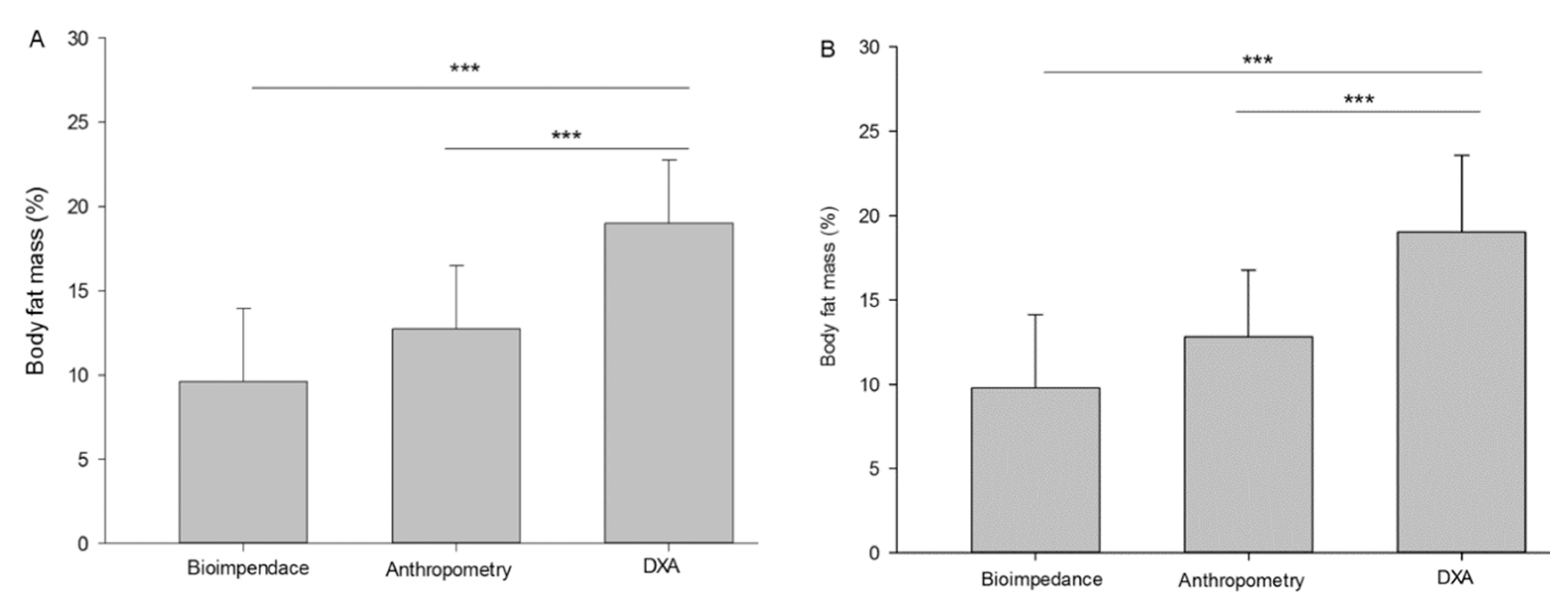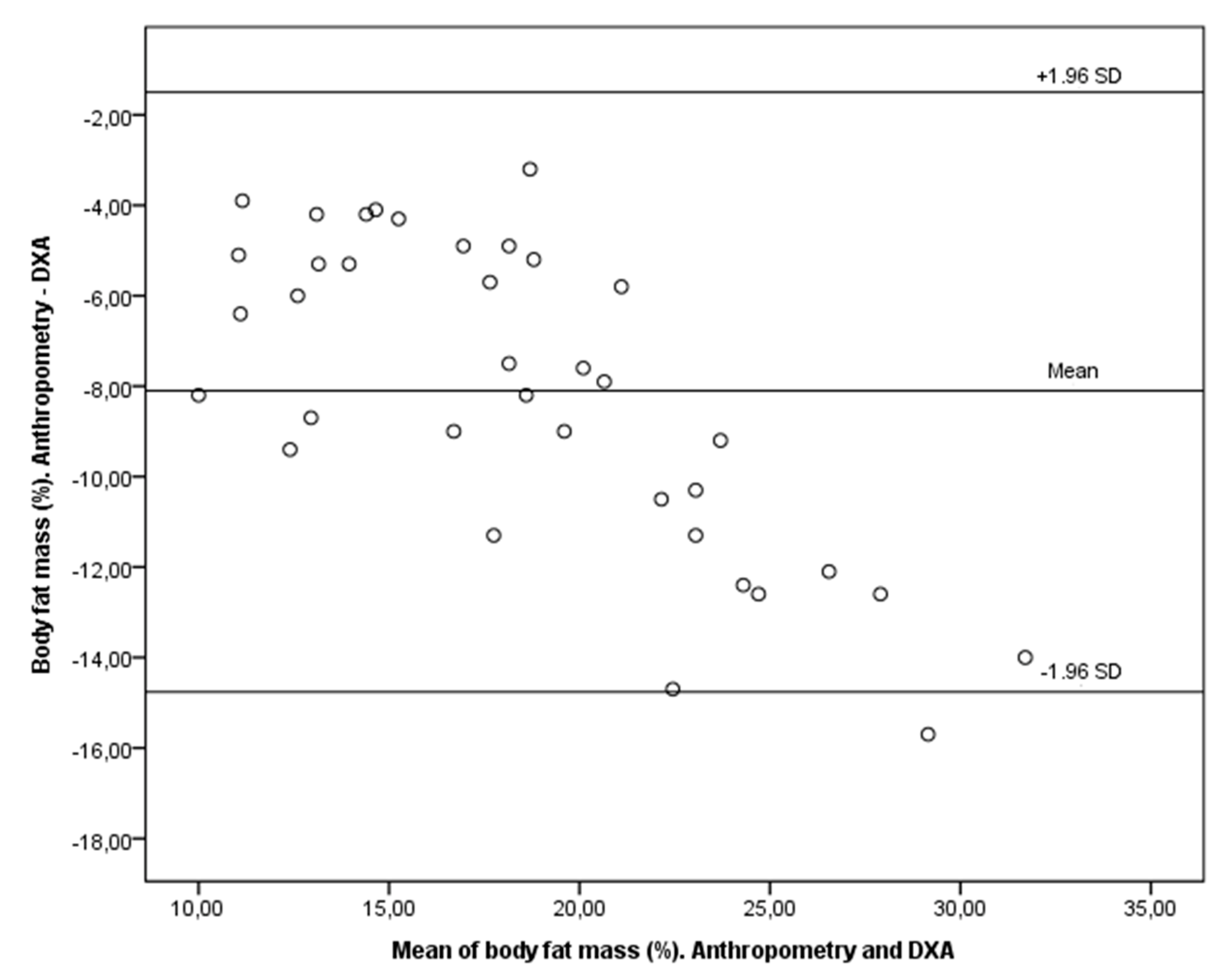Differences in Body Composition Analysis by DEXA, Skinfold and BIA Methods in Young Football Players
Abstract
1. Introduction
2. Materials and Methods
2.1. Anthropometry Measurements
2.2. Bioelectrical Impedance Analysis
2.3. Dual Energy X-ray Absorptiometry
2.4. Statistical Analysis
3. Results
4. Discussion
5. Practical Applications
6. Future Lines of Research and Limitation of the Study
7. Conclusions
Author Contributions
Funding
Institutional Review Board Statement
Informed Consent Statement
Data Availability Statement
Acknowledgments
Conflicts of Interest
References
- Inoue, Y.; Qin, B.; Poti, J.; Sokol, R.; Gordon-Larsen, P. Epidemiology of Obesity in Adults: Latest Trends. Curr. Obes. Rep. 2018, 7, 276–288. [Google Scholar] [CrossRef] [PubMed]
- Nishida, C.; Ko, G.T.; Kumanyika, S. Body Fat Distribution and Noncommunicable Diseases in Populations: Overview of the 2008 WHO Expert Consultation on Waist Circumference and Waist-Hip Ratio. Eur. J. Clin. Nutr. 2010, 64, 2–5. [Google Scholar] [CrossRef] [PubMed]
- Lira, F.S.; Rosa, J.C.; Pimentel, G.D.; Tarini, V.A.F.; Arida, R.M.; Faloppa, F.; Alves, E.S.; do Nascimento, C.O.; Oyama, L.M.; Seelaender, M.; et al. Inflammation and Adipose Tissue: Effects of Progressive Load Training in Rats. Lipids Health Dis. 2010, 9, 109. [Google Scholar] [CrossRef] [PubMed]
- Nikolaidis, P.T.; Vassilios Karydis, N. Physique and Body Composition in Soccer Players across Adolescence. Asian J. Sports Med. 2011, 2, 75–82. [Google Scholar] [CrossRef] [PubMed]
- Spartali, I.; Kostantinos, H.; Ioannis, K.; Thrasivoulos, P. Body Fat Percentage and Body Mass Index as Predictors of Cadets’ Physical Performance. Open Sports Sci. J. 2014, 7, 53–59. [Google Scholar] [CrossRef]
- Zsidegh, P.; Photiou, A.; Mészáros, Z.; Prókai, A.; Vajda, I.; Sziva, Á.; Mészáros, J. Body Mass Index, Relative Body Fat and Physical Performance of Hungarian Roma Boys. Kinesiology 2007, 39, 15–20. [Google Scholar]
- Farsijani, S.; Santanasto, A.J.; Miljkovic, I.; Boudreau, R.M.; Goodpaster, B.H.; Kritchevsky, S.B.; Newman, A.B. The Relationship Between Intermuscular Fat and Physical Performance Is Moderated by Muscle Area in Older Adults. J. Gerontol. A. Biol. Sci. Med. Sci. 2021, 76, 115–122. [Google Scholar] [CrossRef]
- Núñez, F.J.; Munguía-Izquierdo, D.; Suárez-Arrones, L. Validity of Field Methods to Estimate Fat-Free Mass Changes Throughout the Season in Elite Youth Soccer Players. Front. Physiol. 2020, 11, 16. [Google Scholar] [CrossRef]
- Durnin, J.V.; Womersley, J. Body Fat Assessed from Total Body Density and Its Estimation from Skinfold Thickness: Measurements on 481 Men and Women Aged from 16 to 72 Years. Br. J. Nutr. 1974, 32, 77–97. [Google Scholar] [CrossRef]
- González-Ruíz, K.; Medrano, M.; Correa-Bautista, J.E.; García-Hermoso, A.; Prieto-Benavides, D.H.; Tordecilla-Sanders, A.; Agostinis-Sobrinho, C.; Correa-Rodríguez, M.; Schmidt Rio-Valle, J.; González-Jiménez, E.; et al. Comparison of Bioelectrical Impedance Analysis, Slaughter Skinfold-Thickness Equations, and Dual-Energy X-ray Absorptiometry for Estimating Body Fat Percentage in Colombian Children and Adolescents with Excess of Adiposity. Nutrients 2018, 10, 1086. [Google Scholar] [CrossRef]
- Aldobali, M.; Pal, K. Bioelectrical Impedance Analysis for Evaluation of Body Composition: A Review. In 2021 International Congress of Advanced Technology and Engineering (ICOTEN); IEEE: Piscataway, NJ, USA, 2021; pp. 1–10. [Google Scholar]
- Thakur, H.K.; Pareek, P.A.; Sayyad, M.G. Comparison of Bioelectrical Impedance Analysis and Skinfold Thickness to Determine Body Fat Percentage among Young Women. Curr. Res. Nutr. Food Sci. J. 2022, 10, 295–301. [Google Scholar] [CrossRef]
- Slaughter, M.H.; Lohman, T.G.; Boileau, R.A.; Horswill, C.A.; Stillman, R.J.; Van Loan, M.D.; Bemben, D.A. Skinfold Equations for Estimation of Body Fatness in Children and Youth. Hum. Biol. 1988, 60, 709–723. [Google Scholar]
- Munguía-Izquierdo, D.; Suárez-Arrones, L.; Di Salvo, V.; Paredes-Hernández, V.; Ara, I.; Mendez-Villanueva, A. Estimating Fat-Free Mass in Elite Youth Male Soccer Players: Cross-Validation of Different Field Methods and Development of Prediction Equation. J. Sports Sci. 2019, 37, 1197–1204. [Google Scholar] [CrossRef]
- Radley, D.; Gately, P.J.; Cooke, C.B.; Carroll, S.; Oldroyd, B.; Truscott, J.G. Percentage Fat in Overweight and Obese Children: Comparison of DEXA and Air Displacement Plethysmography. Obes. Res. 2005, 13, 75–85. [Google Scholar] [CrossRef]
- Lazzer, S.; Bedogni, G.; Agosti, F.; De Col, A.; Mornati, D.; Sartorio, A. Comparison of Dual-Energy X-ray Absorptiometry, Air Displacement Plethysmography and Bioelectrical Impedance Analysis for the Assessment of Body Composition in Severely Obese Caucasian Children and Adolescents. Br. J. Nutr. 2008, 100, 918–924. [Google Scholar] [CrossRef]
- Eisenkölbl, J.; Kartasurya, M.; Widhalm, K. Underestimation of Percentage Fat Mass Measured by Bioelectrical Impedance Analysis Compared to Dual Energy X-Ray Absorptiometry Method in Obese Children. Eur. J. Clin. Nutr. 2001, 55, 423–429. [Google Scholar] [CrossRef]
- Suarez, V.C.; Campo, D.R.; Gonzalez-Rave, J.M. Modifications to Body Composition after Running an Alpine Marathon: Brief Clinical Report. Int. Sport. J. 2011, 12, 133–140. [Google Scholar]
- Libber, J.; Binkley, N.; Krueger, D. Clinical Observations in Total Body DEXA: Technical Aspects of Positioning and Analysis. J. Clin. Densitom. Off. J. Int. Soc. Clin. Densitom. 2012, 15, 282–289. [Google Scholar] [CrossRef]
- Rodríguez, G.; Moreno, L.; Blay, G.; Blay, V.; Fleta, J.; Sarría, A.; Bueno, M. Body Fat Measurement in Adolescents: Comparison of Skinfold Thickness Equations with Dual-Energy X-ray Absorptiometry. Eur. J. Clin. Nutr. 2005, 59, 1158–1166. [Google Scholar] [CrossRef] [PubMed]
- Cedillo, Y.E.; Knight, R.O.; Darnell, B.; Fernandez, J.R.; Moellering, D.R. Body Fat Percentage Assessment Using Skinfold Thickness Agrees with Measures Obtained by DEXA Scan in African American and Caucasian American Women. Nutr. Res. 2022, 105, 154–162. [Google Scholar] [CrossRef]
- Lozano Berges, G.; Matute Llorente, Á.; Gómez Bruton, A.; González Agüero, A.; Vicente Rodrígue, G.; Casajús, J.A. Body Fat Percentage Comparisons between Four Methods in Young Football Players: Are They Comparable? In Nutrición Hospitalaria; Scieloes: Peninsula, South Africa, 2017; pp. 1119–1124. [Google Scholar]
- Slimani, M.; Nikolaidis, P.T. Anthropometric and Physiological Characteristics of Male Soccer Players According to Their Competitive Level, Playing Position and Age Group: A Systematic Review. J. Sports Med. Phys. Fitness 2019, 59, 141–163. [Google Scholar] [CrossRef] [PubMed]
- Milanovic, Z.; Sporis, G.; Trajkovic, N. Differences in Body Composite and Physical Match Performance in Female Soccer Players According to Team Position. J. Hum. Sprot Exerc. 2012, 7, 67–72. [Google Scholar] [CrossRef]
- Milanović, Z.; Sporiš, G.; James, N.; Trajković, N.; Ignjatović, A.; Sarmento, H.; Trecroci, A.; Mendes, B.M.B. Physiological Demands, Morphological Characteristics, Physical Abilities and Injuries of Female Soccer Players. J. Hum. Kinet. 2017, 60, 77–83. [Google Scholar] [CrossRef] [PubMed]
- Suarez-Arrones, L.; Petri, C.; Maldonado, R.A.; Torreno, N.; Munguía-Izquierdo, D.; Di Salvo, V.; Méndez-Villanueva, A. Body Fat Assessment in Elite Soccer Players: Cross-Validation of Different Field Methods. Sci. Med. Footb. 2018, 2, 203–208. [Google Scholar] [CrossRef]
- Devlin, B.L.; Kingsley, M.; Leveritt, M.D.; Belski, R. Seasonal Changes in Soccer Players’ Body Composition and Dietary Intake Practices. J. Strength Cond. Res. 2017, 31, 3319–3326. [Google Scholar] [CrossRef]
- Milsom, J.; Naughton, R.; O’Boyle, A.; Iqbal, Z.; Morgans, R.; Drust, B.; Morton, J.P. Body Composition Assessment of English Premier League Soccer Players: A Comparative DEXA Analysis of First Team, U21 and U18 Squads. J. Sports Sci. 2015, 33, 1799–1806. [Google Scholar] [CrossRef]
- Martinez-Ferran, M.; Rafei, E.; Romero-Morales, C.; Pérez-Ruiz, M.; Lam-Meléndez, A.; Munguia-Izquierdo, D.; Pareja-Galeano, H. Optimizing Field Body Fat Percentage Assessment in Professional Soccer Players. Appl. Sci. 2022, 12, 727. [Google Scholar] [CrossRef]
- Slimani, M.; Znazen, H.; Miarka, B.; Bragazzi, N.L. Maximum Oxygen Uptake of Male Soccer Players According to Their Competitive Level, Playing Position and Age Group: Implication from a Network Meta-Analysis. J. Hum. Kinet. 2019, 66, 233–245. [Google Scholar] [CrossRef]
- Karastergiou, K.; Smith, S.R.; Greenberg, A.S.; Fried, S.K. Sex Differences in Human Adipose Tissues-the Biology of Pear Shape. Biol. Sex Differ. 2012, 3, 13. [Google Scholar] [CrossRef]
- Munguia-Izquierdo, D.; Suarez-Arrones, L.; Di Salvo, V.; Paredes-Hernandez, V.; Alcazar, J.; Ara, I.; Kreider, R.; Mendez-Villanueva, A. Validation of Field Methods to Assess Body Fat Percentage in Elite Youth Soccer Players. Int. J. Sports Med. 2018, 39, 349–354. [Google Scholar] [CrossRef]
- Collins, J.; Maughan, R.J.; Gleeson, M.; Bilsborough, J.; Jeukendrup, A.; Morton, J.P.; Phillips, S.M.; Armstrong, L.; Burke, L.M.; Close, G.L.; et al. UEFA Expert Group Statement on Nutrition in Elite Football. Current Evidence to Inform Practical Recommendations and Guide Future Research. Br. J. Sports Med. 2021, 55, 416. [Google Scholar] [CrossRef]
- Bosy-Westphal, A.; Schautz, B.; Later, W.; Kehayias, J.J.; Gallagher, D.; Müller, M.J. What Makes a BIA Equation Unique? Validity of Eight-Electrode Multifrequency BIA to Estimate Body Composition in a Healthy Adult Population. Eur. J. Clin. Nutr. 2013, 67 (Suppl. S1), S14–S21. [Google Scholar] [CrossRef]
- Achamrah, N.; Colange, G.; Delay, J.; Rimbert, A.; Folope, V.; Petit, A.; Grigioni, S.; Déchelotte, P.; Coëffier, M. Comparison of Body Composition Assessment by DEXA and BIA According to the Body Mass Index: A Retrospective Study on 3655 Measures. PLoS ONE 2018, 13, e0200465. [Google Scholar] [CrossRef]
- Ackland, T.R.; Lohman, T.G.; Sundgot-Borgen, J.; Maughan, R.J.; Meyer, N.L.; Stewart, A.D.; Müller, W. Current Status of Body Composition Assessment in Sport: Review and Position Statement on Behalf of the Ad Hoc Research Working Group on Body Composition Health and Performance, under the Auspices of the I.O.C. Medical Commission. Sports Med. 2012, 42, 227–249. [Google Scholar] [CrossRef]



| Variables | Females (n = 70) | Males (n = 76) | Statistical Significance |
|---|---|---|---|
| Age (yrs) | 22.3 ± 3.2 | 21.8 ± 5.0 | p > 0.05 |
| Stature (cm) | 162.1 ± 6.5 | 175.0 ± 7.1 | p < 0.001 |
| Weight (kg) | 59.6 ± 8.3 | 71.4 ± 7.1 | p < 0.001 |
| BMI (kg/m2) | 22.7 ± 2.6 | 23.3 ± 2.1 | p > 0.05 |
| Fat mass (%). Bioimpedance | 14.9 ± 5.6 | 9.3 ± 4.3 | p < 0.01 |
| Fat mass (%). Anthropometry | 17.8 ± 3.7 | 12.7 ± 3.7 | p < 0.001 |
| Fat mass (%). DEXA | 29.2 ± 4.8 | 19.0 ± 3.7 | p < 0.001 |
| ∑6 skinfold measurements | 91.8 ± 23.7 | 61.7 ± 20.8 | p < 0.001 |
| ∑8 skinfold measurements | 117.7 ± 29.1 | 81.0 ± 27.5 | p < 0.001 |
Publisher’s Note: MDPI stays neutral with regard to jurisdictional claims in published maps and institutional affiliations. |
© 2022 by the authors. Licensee MDPI, Basel, Switzerland. This article is an open access article distributed under the terms and conditions of the Creative Commons Attribution (CC BY) license (https://creativecommons.org/licenses/by/4.0/).
Share and Cite
Tornero-Aguilera, J.F.; Villegas-Mora, B.E.; Clemente-Suárez, V.J. Differences in Body Composition Analysis by DEXA, Skinfold and BIA Methods in Young Football Players. Children 2022, 9, 1643. https://doi.org/10.3390/children9111643
Tornero-Aguilera JF, Villegas-Mora BE, Clemente-Suárez VJ. Differences in Body Composition Analysis by DEXA, Skinfold and BIA Methods in Young Football Players. Children. 2022; 9(11):1643. https://doi.org/10.3390/children9111643
Chicago/Turabian StyleTornero-Aguilera, José Francisco, Bella Esperanza Villegas-Mora, and Vicente Javier Clemente-Suárez. 2022. "Differences in Body Composition Analysis by DEXA, Skinfold and BIA Methods in Young Football Players" Children 9, no. 11: 1643. https://doi.org/10.3390/children9111643
APA StyleTornero-Aguilera, J. F., Villegas-Mora, B. E., & Clemente-Suárez, V. J. (2022). Differences in Body Composition Analysis by DEXA, Skinfold and BIA Methods in Young Football Players. Children, 9(11), 1643. https://doi.org/10.3390/children9111643







